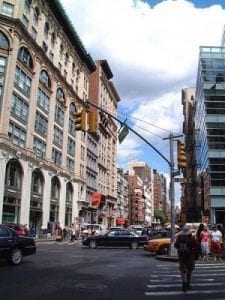Are solar roadways the future of alternative energy? Here’s the science behind driving on solar panels
“Solar Roadways” is not a terribly recent project, having begun several years ago, but it has been a somewhat viral story on the internet for the past few months–with hardly any scrutiny. The results page on Google after typing in “solar roadways” is dominated by scientifically illiterate “journalists” who obsess over it without even bothering to do the most rudimentary research. At first, the idea of solar roadways does sound revolutionary—it’d be a brilliant way to solve our ever-increasing energy crisis and provide us with a surplus of energy on a scale that humans have never before seen. But unfortunately for anyone who donated money to Solar Roadways Inc., adding a moment’s thought to the equation makes the flaws of this proposal become abundantly clear. As with most matters in life and the internet: if it sounds too good to be true, it probably is.
Very briefly—before I get into exposing “solar roadways” for the bullshit that it really is—I must call attention to the website itself, wherein an attempt is made to preemptively discredit those who “reflexively dismiss [their] concept”. Solar Roadways Inc. poisons the well (a very commonly used fallacy) by saying, “there have always been people against change,” that they, “must be descendants of those who argued that the earth was flat,” or said, “we don’t need cars because horses work just fine”. Obviously, we don’t know which of us are descended from the people who argued Earth was flat. The creators of solar roadways, Julie and Scott Brusaw, could very well be the descendents of a person who thought the earth was flat. This argument is laughable at best. So no, this has nothing to do with anyone being against change. Solar roadways are fundamentally unviable, and this article will explain why.
Let’s first go through and examine what these people promise solar roadways will do. From their video, “Solar Freakin’ Roadways,” we are told the following:
- 0:12 “It’s technology that replaces all roadways, parking lots, sidewalks, driveways, tarmacs, bike paths, and outdoor recreation surfaces with solar panels—and not just lifeless, boring solar panels! Smart, microprocessing, interlocking, hexagonal solar units.”
-
0:34 “These are intelligent solar panels, replaced a panel at a time if damaged or malfunctioning. They’re covered with a new tempered glass material that has been designed and tested to meet all impact, load, and traction requirements.”
- 1:17 “For those in the north, the panels use energy they collect to power elements that keep the surface temperature a few degrees above freezing. They’re heated! No more ice and snow on roads causing traffic delays, accidents, and injury. No more shoveling your driveway or sidewalk, no more salt corroding your car, and no more wasting tax money on snow removal.”
-
1:37 “Every panel has a series of LED lights on the circuit board that can be programmed to make lanescape designs, warning signs, parking lot configurations, whatever. These roads never have to have lanes repainted; just reprogrammed to whatever we choose or whatever works best…. With LED lights under your feet, it’s gonna look like freakin’ Tron out there!”
-
2:12 “These panels are also pressure-sensitive, so they can detect when large debris like branches or boulders have fallen onto the road. Or if an animal is crossing, it can warn drivers with LED text to slow down for an obstruction.”
- 2:26 “Solar roadways use as much recycled material in their production as possible” with a “cable corridor that runs concurrently with the roadways themselves. One part houses electrical cables [including] high speed internet…. (2:50) The other channel captures and filters storm water and melted snow, moving them either to a treatment facility or treating them on-site.”
- 3:04 “Do you realize how many thousands of jobs this could create and sustain? …And it pays for itself! They’re solar freakin’ roadways!”
-
3:17 “Is this even possible? I told you, YES.”
No. It isn’t. I hate to be a buzzkill for anyone who might’ve been looking forward to living in “Tron,” but there are much better ways to solve the energy crisis. I will definitely concede that the idea is extremely cool. It’d be great if all the roads in America generated electricity and lit up with different patterns and melted the snow and filtered the rainwater and warned us of hazards. But in reality, accomplishing all those tasks at once turns out to be a pretty demanding job. Then factor in the tasks a road must accomplish normally, which is provide traction for heavy vehicles in all types of weather all year round, and it doesn’t take a keen eye to notice the logistical nightmare involved with this project.
COOL NEW REVOLUTIONARY DESIGN!
Lets begin with this stylish-looking hexagonal shape. If hexagonal tiles were a more efficient design than paved roads, surely we’d have figured that out by now and all our roads would’ve been laid using hexagons. As it happens, hexagons (or any shape of large tile) are terrible for constructing roads. The larger a tile or tile-like unit is, the more susceptible it is to breaking or cracking through the middle when under pressure. As vehicles roll across these units, it results in differential loading, which means there’s more weight on one side of the tile than the other. Over time, this causes the tile to come loose or break all together.

The solar units would likely need to be swapped out and replaced regularly, and if anyone thought
highway repair was pricey before, think of how much more expensive replacing miles of technology would be instead of asphalt. But let’s get into the economics a little later.
While we’re still on the topic of flawed road designs, let’s take a minute to think about the prospect of driving on glass. The video shows the Brusaws shoveling a small pile of multi-colored glass shards into a wheelbarrow, as we are told solar roadways use as much recycled material as possible in production. I’m all for being ‘green’, but melting down differently colored glass and turning it into the clear glass used on the solar units is just not possible. Even if they did melt it down it’d just end up being a blend of all the colors, which would obviously hinder the panel’s light-collecting abilities. Besides that, it’s clear the Brusaws aren’t even close to having the assets required to operate the type of facility for large-scale glass melting and recasting. I can’t be the only one who thinks it’s completely absurd that they’re shoveling a tiny pile of glass shards into a wheelbarrow. It’s obvious they can’t melt it down, so why are they filming themselves doing a pointless task? (Fun fact: asphalt is one of the most commonly recycled materials ever, with up to 99% of it being reused).
The video also claims the panels meet all “impact, load, and traction requirements,” and shows a tractor driving over the prototype solar roadway. Call me skeptical, but I don’t think a tiny tractor driving 5 mph over maybe 50 ft of roadway would satisfy any such impact, load, or traction requirements they were referring to. But rubber on glass does produce a significant amount of traction, right? Yes, it does, but pretty much only when conditions are clean and dry. Driving on glass roads might be a little less absurd in a region that doesn’t ever rain or snow (yet is still somehow habitable) but most cities in the U.S. will get, at the very least, several inches of precipitation every year. I wonder how an 80,000 lb cargo truck driving at 60 mph in the rain would fare if it needed to stop abruptly going downhill on one of these roads. My guess is not well.
The brail bumps on the surface of the glass would not necessarily help traction, either. For one, the mechanisms that produce traction between a car tire and asphalt occur at a much smaller level than the macroscopic pattern of aberrations designed on the glass. For another, glass is a relatively soft material and tends to erode quickly. Sea glass is a perfect example of what happens to glass when exposed to continuous friction and pressure over the course of years and decades. Moreover, as glass further erodes, it becomes opaque, which defeates the entire purpose of the solar unit to begin with. But—but it’s tempered glass!
Yes, tempered glass is indeed stronger than non-tempered glass, but it isn’t any harder, nor is it less susceptible to erosion. It’s great for resisting blows from large, blunt objects, but it’ll shatter if struck by a tiny point, which are common among debris found outdoors. Tempered glass can be shattered simply by throwing a small piece of porcelain at it, as demonstrated in the below video.
The solar roadways website also makes a point out of the fact that glass is harder than steel, and says that asphalt is therefore softer than glass. It’s true that glass is harder than steel according to Mohs Scale of Hardness, but whoever made this claim is confusing steel’s hardness with some of its other properties, namely, its tensile strength. Steel is great for resisting tension, which is why suspension bridges are made out of steel and not glass. Similarly, the claim also confuses the terms “asphalt” with “blacktop”. The terms are used interchangeably in everyday conversation, but technically speaking they are entirely distinct. Asphalt is the pitch black gooey, malleable stuff you sometimes see used to repair cracks in the road—obviously glass is harder than malleable goo. Blacktop, on the other hand, is the combination of that, plus small pieces of gravel and rock—asphalt is heated and mixed with gravel to create blacktop, which is then called “asphalt” in everyday context. Normal, old fashioned, out-of-date roads are basically gravel glued together by asphalt. The asphalt creates a semi-waterproof seal, and the gravel produces tiny ridges and imperfections in the road that produce far better traction for a rubber tire than glass ever could. And, as mentioned earlier, it’s up to 99% recycled.
IT’S GONNA BE LIKE FREAKIN’ TRON OUT THERE!
Now that most of the seemingly obvious issues with design and building materials have been exposed, let’s move on to the absurdity of solar roadways’ proposed function.
First of all, I don’t want it to be like “freakin’ Tron out there”. The light pollution is disturbing enough as it is and I’d much rather see the stars shine above my head at night than feel like I’m living in a nauseatingly cheesy replica of an 80’s video game. However, fortunately for the stars, there won’t be any LED light pollution, because there won’t be any LED lights, because there won’t be any solar freakin’ roadways. We can know this for a fact thanks to this little thing called conservation of energy.
I know it’s scary, but we’re going to have to do something no one wants to do… MATH. But we need to expose some bullshit so let’s just get it over with. If we use the figure stated in the video, there are 25,000 square miles of roadway in the United States. This is roughly equal to 60 billion square meters (64.75 billion, but 60 billion for simplicity).
“If we covered that in solar panels with just a 15% efficiency, we’d produce three times as much electricity as this country uses on an annual basis.”
Nothing wrong with the math here, at least in principal. Yes, if 25,000 square miles of roadway were covered in solar panels with a 15% efficiency, we would produce three times as much energy as this country uses annually, if the panels collected solar energy 24 hours a day.
But recall that the solar units have LED lighs on them to produce road markings. So how exactly would they produce this much energy when the sun is down, while the LED lights need to be powered? Where is that energy coming from?
Now here’s where the math comes in. I know, it sucks but just stay with me.
It takes about four of these panels to make one square meter. We know there are 25,000 square miles of roadway, equal to roughly 60 billion square meters that need to be covered. Four panels = 1 m squared, thus we would need about 240 billion panels, or just under two and a half times the number of stars in the Milky Way galaxy, or 800 panels for every person in America, or 34 panels for every person in the world.
Each one of these solar units has fifty LED’s on them (which aren’t even formatted to create the designs depicted in the renderings, by the way), and with 240 billion panels covering 25,000 sqare miles of roadway, that gives us a whoppong 12 trillion LED lights. To put that number in perspective, it’s over twice the distance to the sun—in inches.
Now, a string of 300 LED’s runs on about 60 watts. So 60w = 0.06 kW and 0.06 kW @ 7 cents /kHW = 0.06 x 0.07 = $0.0042. In other words, the cost of running 300 LED’s for 1 hour is less than half a cent. However, when all 12 trillion of them are running, it’ll cost $1.4 trillion per year, $4 billion per day, and $168 million per hour. That’s an extra $5,000 burden on all 300 million Americans every year.
However, if we did light up the roads like an obnixious LED billboard, it would require them to consume more energy than is actually available in the direct sunlight. Obvious, since otherwise they would not be visible in direct sunlight. An LED billboard can run at up to 1000w/sq. meter, while an average sqare meter of the earth’s surface recieves about 340w/m^2. Therefore, in order to live in “Tron,” we’ll say the roads consume about 500w/m^2. Let’s calculate the energy bill, should this fantasy be turned into reality. 65,000,000,000/m^2 x 500w @ $0.07/kW/hr = 2 billion dollars per hour. The electricity bill alone would cost upwards of 20 trillion dollars per year.
Additionally, LED lights are only good for five to seven years in normal conditions that don’t involve being constantly rolled over by trucks and exposure to natural elements. Think about this: the decision to put lights in the roads means that every time the panel needs to be repaired or replaced, traffic must be stopped in order to put the new panel in, which is of course readily on-hand at all times somehow. This means 240 billion panels would need to be replaced every five to seven years. And what if the solar panels still work but the bulbs don’t? What sort of mechanism is there to replace just the 12 trillion bulbs and not the 240 billion panels every seven years amid rush hour traffic?
Furthermore, LED lights have terrible visibility in direct sunlight and at shallow angles. That’s why a shade is placed over traffic lights to keep the direct sunlight off them. LED billboards, like traffic lights, are at near-right angles to our line of sight, which vastly improves its visibility. It’s practically impossible to see an LED light at a shallow angle (as it would be to a driver) in direct sunlight. View more in the video below from 11:45 to 12:40.
But let’s just ignore all that for now and say LED’s in the roads is a good idea. Remember that whole conservation of energy thing? Well, as it turns out, a half meter by half meter solar unit completely covered in solar cells at 20% efficiency puts out roughly 40w when in direct sunlight and angled toward the sun. The hexagonal units appear to be about 60% covered in solar cells and run at 15% efficiency, but let’s just say they run at 20% and put out 40w for now.
Since there are 50 LED’s on one panel, it takes about 10w to power them. No conflict there, but recall the panel is in direct sunlight and angled toward the sun. Solar panels at solar farms track the sun, which means they’re pointed directly at it the entire day. When the panel is laid flat on the road and does not track the sun, it loses about 2/3 of its efficiency, at which point a panel that would put out 40w would only put out 13w.

Then, subtracting the 10w to power the LED’s we are left with a measly 3w… and yet these lights must be left on at night, when the panel isn’t collecting any energy.
In addition, every time you convert sunlight into electricity and then into LED light, you’re going to lose energy along the way. These panels could power maybe ten LED’s 24/7. How do these people expect to power all 12 trillion LED lights when the energy required to power them exceeds the amount of energy collected by the solar cells? And if LED’s are best visible in the shade, and solar cells function best in direct sunlight, how exactly is this magical piece of technology supposed to work?
But recall that I used very generous figures. The actual solar roadway panel is about 60% covered in solar cells at 15% efficiency, does not track the sun, and is covered in thick, tempered glass—and they’re heated!
NO MORE ICE AND SNOW ON ROADS?!
That’s right, they’ve still got enough energy laying around to turn ice into water! Admittedly, to laypeople this may not sound like a big deal, but it really is.
From the Solar Roadways website:
“Over 70 percent of the nations roads are located in snowy regions, which receive more than five inches (or 13 cm) average snowfall annually…. Each year, 24 percent of weather-related vehicle crashes occur on snowy, slushy or icy pavement. Over 1,300 people are killed and more than 116,800 people are injured in vehicle crashes on snowy, slushy or icy pavement annually. Snow and ice increase road maintenance costs. Winter road maintenance accounts for roughly 20 percent of state DOT maintenance budgets. State and local agencies spend more than 2.3 billion dollars on snow and ice control operations annually…. Does the current system of snow removal sound cheap to anyone? What would saving over 1300 lives and preventing over 115,000 injuries per year be worth?”
You read that correctly; their entire argument is, “Does the current system of snow removal sound cheap to anyone?” Seriously, I almost can’t believe it’s this easy. Let us once again call upon our old friend, MATH.
First of all, this idea can be refuted with just a moment’s thought—that being, if it were cheaper to melt snow rather than move it to the side of the road, why aren’t snow removal trucks fitted with flamethrowers? But some people see that as facetious so let’s get practical and do the calculations.
Thanks to our other old friend, thermodynamics, we know that it requires 334 kilojoules per kilogram to turn ice at freezing point into water at freezing point. To put it into perspective, that same amount of energy will heat water at 0*C to 70*C, or just over 2/3 of the way to boiling. The average snowfall cited is 13 cm, which is roughly equivalent to 1.3 cm of ice. Factor in the road area, 65 billion/m^2, and we get 0.85 billion/m^3 = 0.85 trillion kg of ice to melt. Roughly 330 kJ per kg to melt ice = 75 billion kW hrs @ $0.07/hr = 5 billion dollars per year. So instead of spending all this money on snow removal, they propose an idea to save money by doing something that would cost twice as much even if it worked at 100% efficiency: they propose using as much energy to heat water from 0*C to almost boiling over the entire continental US road system.
Let me also point out that these panels will be in the northern regions of America—regions that receive far less sunlight on average. These panels, located in regions with little sunlight, are expected to melt the snow that’s covering them? How would a solar panel collect sunlight to produce energy to melt snow when the snow is blocking the sunlight necessary for collecting energy?

And remember these magic ice-melting solar panels are also supposed to light up the road like “Tron” 24 hours a day. Is the ridiculousness of this concept not becoming abundantly clear? The idea is fundamentally and demonstrably impossible, but the website isn’t through with making absurd claims yet.
OH YEAH, THEY’RE PRESSURE-SENSITIVE!
Alright, so not only are these 240 billion hexagonal, programmable LED, tempered glass-covered, load-bearing solar units going to be heated, they’re going to be pressure-sensitive, too! Yeah, they’re going to light up if a deer walks on it or if a tree falls or if boulders obstruct a mountain roadway. So anything from a 200-lb animal to a several-tons boulder will be visible to drivers. They’re also going to display text warning drivers of any hazards ahead of time. Isn’t this just the most ingenius idea ever?!
One question: why didn’t the road light up when the tracktor was driving on it? Should there not have been LED’s lighting up beneath the tires of the tracktor since the road is pressure-sensitive? Plus, there are a lot of cars out there. Roads are pretty much driven on 24 hrs a day, which means these pressure-sensitive solar-powered roads are going to have the additional task of lighting up beneath vehicles in conjunction with the basic road markings. The road would stay lit-up beneath parked cars, defeating the entire purpose of covering parking lots in solar panels. Cars parked on these things will block the sunlight from reaching the cells, while the road uses energy to light-up under the weight of the car.
Obviously this would require each of the 240 billion panels to be fitted with the electrical circuitry of a digital scale with a range of several pounds to several tens of thousands of pounds. To give an idea of the scope of this proposal, let’s calculate the cost of the cheapest part required: the glass.
As previously mentioned, the panels are roughly one square meter. According to the internet, the going price for one square meter of 1/2” thick tempered glass goes for between $300 – $350. Therefore, since we know the area intended to be covered (65 billion/m^2) we can know the total cost of the glass. This does not include the cost of the circuitry, microprocessors, silicon, high-speed internet, pressure-sensitive electronics, and LED lights. This excludes the cost of the power system this project demands; the steel and concrete used for the buried cables; nor does this include the cost of the heating elements, nor does it include the cost of the solar cells themselves. Ignoring even the manpower required to bring this vision to life, the price tag on the glass alone comes out to: 65 billion/m^2 x $300/m^2 = 19,500,000,000,000 or 20 trillion dollars with tax, or approximately 10 times the federal budget.
MILITARY APPLICATIONS
I’ve saved the best for last. These people have even proposed military applications for their ridiculous solar roadway. Check out what they say on their website:
“Imagine being able to put “eyes and ears” on the ground anywhere in the world without putting human lives in danger. Drop a Solar Road Panel into the hills of Afghanistan via parachute. The parachute detaches upon impact and is retracted beneath the panel. Camera modules open and aim in every direction. A satellite dish configures itself for communications to anywhere in the world. Marines at Camp Lejeune, North Carolina control the direction of the infrared cameras and watch the images on their computer screens and call in strikes when needed.”
Seriously? This is a solar panel working at 15% efficiency and they want it to power infared camera modules that aim in every direction and are controlled remotely via satellite?! And this roadway panel is supposed to be air-dropped into the hills of Afghanistan, after which its parachute retracts beneath it into some pocket dimension of extra space. It’s curiously similar to the features of the Mars rover, though. But that’s obviously pure coincidence.
They go on:
“Unlike a conventional generator, the Solar Road Panel makes no noise and leaves no thermal footprint for the enemy combatants to detect. No refueling is ever needed, keeping our troops out of harm’s way.”
Yeah, that’s category 5 bullshit. Even if one square meter of solar cells at 15% efficiency could power a satellite dish and infared cameras and a retractable parachute, and LED lights, it most certainly wouldn’t be doing so without generating any heat signature. Electricity generates heat, plain and simple.
I honestly feel as though these claims are so ridiculous that ultimately they’re their own refutation. It just comes down to the materials. In order for this to be even remotely possible, there needs to be a material as transparent as glass, yet as hard and rough as asphalt that can be mass-produced in a cost-effective way. This material simply does not exist. It’s like a piece of technology straight out of a Marvel comic book
A FEW OTHER THINGS
Here’s just a list of a few other things that I wonder about:
- What purpose does changing the patterns on the roads even serve in the first place? How often is it really necessary to change the patterns on the roads? It reminds me of the Dane Cook bit about changing the roads before he began to completely suck.
- Where is the energy being stored once it’s collected? How is the energy being transported? Are they suggesting high-voltage AC power lines (those enormous power lines propped up by those gigantic metal things) are to be stored in the cable corridor as well?
- How do they propose to convert the few volts generated by the photovoltaics into high-voltage alternating current for transport? Is there to be a high-voltage AC transport system along every road in America?
- Where do they propose to get all this material? The glass, lights, photocells, metal for the wiring, etc? How do they expect to be able to maintain an infastructure of this magnitude?
- Where, exactly, is stormwater going to be filtered? On-site? Where then is this filtered stormwater going to be stored once it’s processed in the secret pocket dimension next to the parachute?
- How do they propose to pay for all this stuff? The 2 million dollars they raised on IndieGoGo? Using math: $20 trillion (glass alone) + $20 trillion (power to actually see it in daylight) + $800 billion (LED lights) = $40.8 trillion dollars. The amount of money they raised is only enough to heat one 370 km-long highway for a single year. In other words, including the $750,000 of taxpayer money they got from the Department of Transportation, they’ve raised a staggering 0.0000000735% of the rough total annual cost of this project.
As I said in the beginning of this article, there are far better ways to solve the energy crisis. Solar is probably the best and most promising way, but putting the panels under the roads is just plain idiotic. The best place to put solar panels, if not above the roads or next to them, is in space. Building solar panels in space that can track the sun 24 hrs a day, that are unimpeded by earth’s atmosphere, that are up to a square kilometer in size, that will be the most efficient solar panels yet produced, that won’t require constant maintainence and that won’t waste energy lighting up like a solar freakin’ disco, will also cost a good amount of money, but it’ll be a tiny fraction of $41 trillion dollars.
But why is this such a big deal? Why is so important that I write almost ten pages debunking this nonsense? The reasons are four-fold: first, Scott and Julie Brusaw duped 50,000 people out of over 2 million dollars by producing a bogus video saturated with pseudo-science. Second, the Brusaws received a $750,000 grant of taxpayer money from the Department of Transportation to fund this project, which can be shown to be fundamentally unviable and demonstrably impractical with just a few calculations and background research. Third, this undermines the credibility of real scientists in public perception. Years from now, when there are no solar roadways, people are liable to say, “why should we believe scientists about _______? [climate change/vaccines/evolution etc.] They told us there’d be solar roads and it’d be like freakin’ Tron out here! But it’s not! WTF!” Fourth, the success of this bogus project shows the patheticly and disturbingly low current science-literacy of our society. It’s understandable that most people can’t be bothered to know things like the relative efficiencies of solar panels, or the properties of tempered glass, or what goes into transporting energy; these things are not common knowledge. But I really don’t understand how at no point along the way did anyone scrutinize this project enough to do the basic calculations before handing these people $750,000 of taxpayer money. At no point along the way did anyone think, “hm, glass roads… I wonder if that’s a good idea…”? Or, “where is all this material going to come from?” No, they just sit and nod and praise its genius. Listen to U.S. Senator Mike Crapo talk about the “over-the-horizon thinking” of solar roadways:
And yet it takes all of maybe one hour to do the calculations and proper research to show that this project is fundamentally unviable. It’s extremely important to expose any and all pseudo-scientific claims that manage to gain this much support and money as quickly as possible because it preserves the integrity of real scientists in public perception. This is in turn vitally important because public perception has a direct effect on our ability to implement future policies based on scientific research that would greatly improve the quality of life in the U. S.
Solar roadways, and other such claims or projects based on pseudo-science like it, muddy the waters in terms of what science actually is to anyone who isn’t already scientifically literate or formally educated in science. The backers of this project will dupe many more people into giving their hard-earned money to fund nonsense before this whole idea finally fizzles out for good, and many more will be disheartened or even upset that it was a scam, but through all of that we can say the one group of people who saw through the smoke and mirrors, and smelled the bullshit from the very start, were the real scientists.

For more information please visit the Thunderf00t YouTube channel:
https://www.youtube.com/user/Thunderf00t/search?query=solar
https://www.youtube.com/channel/UCmb8hO2ilV9vRa8cilis88A














-300x300.jpg)